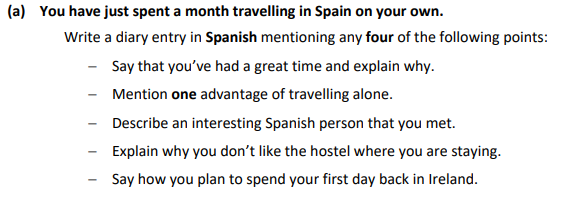¡Hola a todos! Welcome to our blog. In today’s post, we’re talking all about the Spanish Leaving Cert written exam.
The written exam constitutes a significant portion of your overall grade, weighing in at 55% (220 marks). It lasts 2 hours and 30 minutes.


Section A - Reading Comprehension (70 marks)
This section evaluates your comprehension skills in Spanish and comprises prescribed literature or a journalistic text along with two short comprehensions.
Tackling the journalistic text (50 marks) alongside the short comprehensions (20 marks) tends to be a common approach. To enhance performance in this section, here are some tips:
- Time Management: Efficiently managing time is crucial. Dedicate no more than 30 minutes to the journalistic text and rigorously practice comprehensions from previous years’ papers. Time yourself during practice sessions to enhance your speed. Short comprehensions should ideally take no more than 15 minutes each.
- Vocabulary Enhancement: Engaging with Spanish newspapers, particularly through social media platforms like El Mundo, proved invaluable for acquiring vocabulary related to current events. Also immerse yourself further by switching all my social media settings to Spanish and write down useful vocabulary and verbs.
Prescribed Literature
Part 1 gives 3 Spanish phrases or words for which you need to find a phrase or a word with the same meaning.
Part 2 asks you to explain 3 different phrases in English.
Part 3 and 4 ask you a question and you have to include three details in your answer , don’t forget to answer in English this section.
Part 5 you have to discuss the topic.
The Journalistic Text
Part 1 of the journalistic text contains sections (a) to (e). You will be asked questions on the comprehension to see if you understand it. Each question is related to a particular paragraph so read the question, read the paragraph, highlight the answer, and write your answer in English.
Part 2 gives 3 Spanish phrases or words for which you need to find a phrase or a word with the same meaning.
Part 3 asks you to translate the sections of the text given to you.
Part 4 contains 2 Spanish phrases or words. You must give an alternative way of saying it or a synonym.
* Remember, you can choose from doing the Prescribed Literature or the Journalistic Text.
Comprehensions
In this section, you will have to answer the different questions based on the given text.
Section B - Reading Comprehension and Opinion Writing (100 marks)
Section B mirrors the journalistic text but revolves around an opinion piece, accounting for 100 marks. Spending approximately 35 minutes on this section, including 5 minutes for planning and 30 minutes for writing, is advisable.
Similar to the journalistic text, the opinion piece can be dissected into four parts:
- Part 1 gives 3 Spanish phrases or words for which you need to find a phrase or a word with the same meaning. (15 marks)
- Part 2 asks you write in English the meaning of the phrases presented (15 marks)
- Part 3 gives 3 Spanish phrases or words for which you need to find a phrase or a word with the same meaning. (5 marks)
- Part 4 answer questions based on the text.(15 marks)
- Part 5 Your opinion piece (50 marks)
Top Tips: Commence the opinion piece by clearly stating your stance, consistently referencing the title to maintain relevance. Utilize phrases and varied verb tenses judiciously to enrich expression and demonstrate linguistic versatility.
Example of how the opinion piece question might look like:

Section C - Written Production (50 marks)
The first question offers the flexibility of either constructing a dialogue or writing a letter (30 marks)
The Dialogue
It is divided into 5 small paragraphs that you must translate.
The dialogue should take a maximum of 20 minutes (dedicate no more than 4 minutes to each one).
You must translate one side of the dialogue and it’s important to read the context of it.
Read our “Dialogue Construciton” Full blog here to find out more:
Writing a letter
They will outline the points that you have to focus on. Pick five out of eight points presented and choose to agree or disagree with them.
Example of what you might get in your exam:

The final section presents a choice between crafting a diary entry or a note, valued at 20 marks. While both options are viable. Prioritizing varied verb tenses and infusing emotions into reflections enriches the narrative, providing a glimpse into one’s inner thoughts and experiences.
Diary Entry
Use as many verb tenses as possible and remember that emotion is important in a diary entry as it’s supposed to be personal.
Example of instructions you might get in your exam:

Note
Who is the message addressed to ?
Is it formal or informal ?
What is the message about ? Don’t leave out any instructions, they are equally important.
Where you are – if you are leaving a message, it is because you are not there to say it in person.
Example of what you might get in your exam:

In conclusion, understanding the written exam of the Spanish leaving cert is key in order to obtain a good grade. Utilize past papers, marking schemes, and available resources to refine your skills.. We will keep posting more sample answers and tips in the upcoming weeks, so stay tuned! And if you’re looking for even more guidance and preparation for the Leaving Cert, our Spanish courses are an excellent resource. And remember, practice makes perfect!
¡Buena suerte! Good luck on your Spanish Leaving Cert journey!

